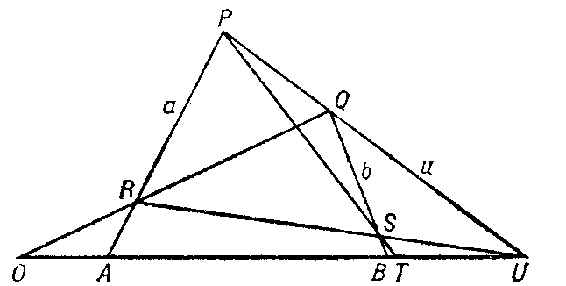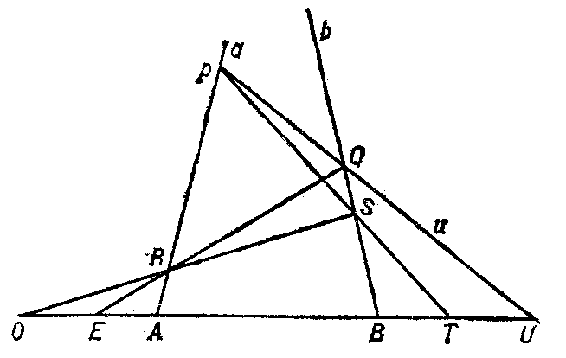Projective algebra
in the narrow sense
An algebra of points on a projective line; projectively-invariant constructions for defining addition and multiplication of points on a projective line  , lying in a projective plane
, lying in a projective plane  for which the Desargues assumption holds. These constructions depend on the choice of three distinct points
for which the Desargues assumption holds. These constructions depend on the choice of three distinct points  on
on  .
.
Construction I
determines for any two points  different from
different from  a third point
a third point  , also different from
, also different from  and called the sum of
and called the sum of  and
and  . One draws in
. One draws in  three straight lines
three straight lines  ,
,  and
and  , different from
, different from  , forming a triangle and passing through
, forming a triangle and passing through  ,
,  and
and  , respectively. Let
, respectively. Let  be the point of intersection of
be the point of intersection of  and
and  , let
, let  be that of
be that of  and
and  ,
,  that of
that of  and
and  , and
, and  that of
that of  and
and  . Then
. Then  intersects
intersects  in the point
in the point  (for the general case see Fig. a). It turns out that the point thus constructed depends on
(for the general case see Fig. a). It turns out that the point thus constructed depends on  ,
,  ,
,  , and
, and  only, and not on the choice of the straight lines or the point
only, and not on the choice of the straight lines or the point  .
.

Figure: p075160a
Construction II
determines for any two points  different from
different from  a third point
a third point  , also different from
, also different from  and called the product of
and called the product of  and
and  . One draws in
. One draws in  three straight lines
three straight lines  ,
,  and
and  , different from
, different from  , forming a triangle and passing through
, forming a triangle and passing through  ,
,  and
and  , respectively. Let
, respectively. Let  be the point of intersection of
be the point of intersection of  and
and  , let
, let  be that of
be that of  and
and  ,
,  that of
that of  and
and  , and
, and  that of
that of  and
and  . Then
. Then  intersects
intersects  in the point
in the point  (for the general case see Fig. b). It turns out that the point thus constructed depends on
(for the general case see Fig. b). It turns out that the point thus constructed depends on  ,
,  ,
,  ,
,  ,
,  only, and not on the choice of the straight lines
only, and not on the choice of the straight lines  ,
,  and
and  . The points of the line
. The points of the line  (distinct from
(distinct from  ) form a skew-field
) form a skew-field  under these operations of addition and multiplication. Interchanging
under these operations of addition and multiplication. Interchanging  and
and  in construction II leads to an anti-isomorphic skew-field
in construction II leads to an anti-isomorphic skew-field  . If
. If  is another triple of points on a straight line
is another triple of points on a straight line  in
in  , then the corresponding skew-field
, then the corresponding skew-field  is isomorphic to
is isomorphic to  , since there is a projective correspondence between
, since there is a projective correspondence between  and
and  . Therefore, any skew-field isomorphic to it is simply called a skew-field of the given projective plane (or even of the given projective geometry). One also says that one has a projective geometry over the skew-field
. Therefore, any skew-field isomorphic to it is simply called a skew-field of the given projective plane (or even of the given projective geometry). One also says that one has a projective geometry over the skew-field  . In the general cases of constructions I and II there figure four points
. In the general cases of constructions I and II there figure four points  ,
,  ,
,  ,
,  , lying in one plane and no three of which are collinear; these form a complete quadrangle with three pairs of opposite sides
, lying in one plane and no three of which are collinear; these form a complete quadrangle with three pairs of opposite sides  ,
,  ;
;  ,
,  ; and
; and  ,
,  . The points
. The points  of intersection of these pairs of opposite sides are called diagonal points, while the straight lines joining diagonal points are called diagonals. A special case, not indicated in the figure, corresponds to the situation that
of intersection of these pairs of opposite sides are called diagonal points, while the straight lines joining diagonal points are called diagonals. A special case, not indicated in the figure, corresponds to the situation that  are collinear (see Fano postulate).
are collinear (see Fano postulate).

Figure: p075160b
Similar constructions can be carried out in a pencil of straight lines passing through a point, using a complete quadrilateral, a figure dual to a quadrangle, and leading to a skew-field  anti-isomorphic to
anti-isomorphic to  .
.
The properties of the projective line  as an algebraic system are determined by the geometric (projectively-invariant) properties of the projective plane in which
as an algebraic system are determined by the geometric (projectively-invariant) properties of the projective plane in which  lies. E.g., commutativity of
lies. E.g., commutativity of  is equivalent to the Pappus axiom being true; Fano's postulate is equivalent to the characteristic of
is equivalent to the Pappus axiom being true; Fano's postulate is equivalent to the characteristic of  being different from 2; if
being different from 2; if  has no other automorphisms but inner ones, then every projective transformation is a collineation, etc.
has no other automorphisms but inner ones, then every projective transformation is a collineation, etc.
Using the skew-field  on the straight line, and hence in the projective space containing the line, one can introduce projective coordinates, giving an algebraic model of the projective space, so that the contents of the projective geometry is, in essence, determined by properties of the same skew-field
on the straight line, and hence in the projective space containing the line, one can introduce projective coordinates, giving an algebraic model of the projective space, so that the contents of the projective geometry is, in essence, determined by properties of the same skew-field  over which it is constructed.
over which it is constructed.
In the wide sense, in projective geometry one studies the set of subspaces of projective space, which is a complemented modular lattice. Here one does not require the space to be finite-dimensional, but imposes the condition of completeness, existence of a homogeneous basis, etc. Accordingly, one can establish various connections with the theory of prime and regular rings, the theory of Abelian operator groups and other branches of algebra.
References
| [1] | W.V.D. Hodge, D. Pedoe, "Methods of algebraic geometry" , 1 , Cambridge Univ. Press (1947) MR0028055 Zbl 0796.14002 Zbl 0796.14003 Zbl 0796.14001 Zbl 0157.27502 Zbl 0157.27501 Zbl 0055.38705 Zbl 0048.14502 |
| [2] | E. Artin, "Geometric algebra" , Interscience (1957) MR1529733 MR0082463 Zbl 0077.02101 |
Comments
A collineation is a linear transformation of the homogeneous coordinates (Baer's terminology, [a2]).
The construction of projective geometry using the properties of its skew-field is rather old; it is essentially due to D. Hilbert [a1]. A modern approach was given by E. Artin [2].
References
| [a1] | D. Hilbert, "Grundlagen der Geometrie" , Teubner, reprint (1968) MR0262046 MR0229120 Zbl 0153.49601 |
| [a2] | R. Baer, "Linear algebra and projective geometry" , Acad. Press (1952) MR0052795 Zbl 0049.38103 |
| [a3] | H.S.M. Coxeter, "The real projective plane" , Cambridge Univ. Press (1961) MR1198272 MR1198271 MR0112071 MR0124786 MR0070189 MR1570447 MR0030205 Zbl 0772.51001 Zbl 0086.35805 Zbl 0090.12104 Zbl 0065.36401 Zbl 0032.11302 |
Projective algebra. Encyclopedia of Mathematics. URL: http://encyclopediaofmath.org/index.php?title=Projective_algebra&oldid=23931